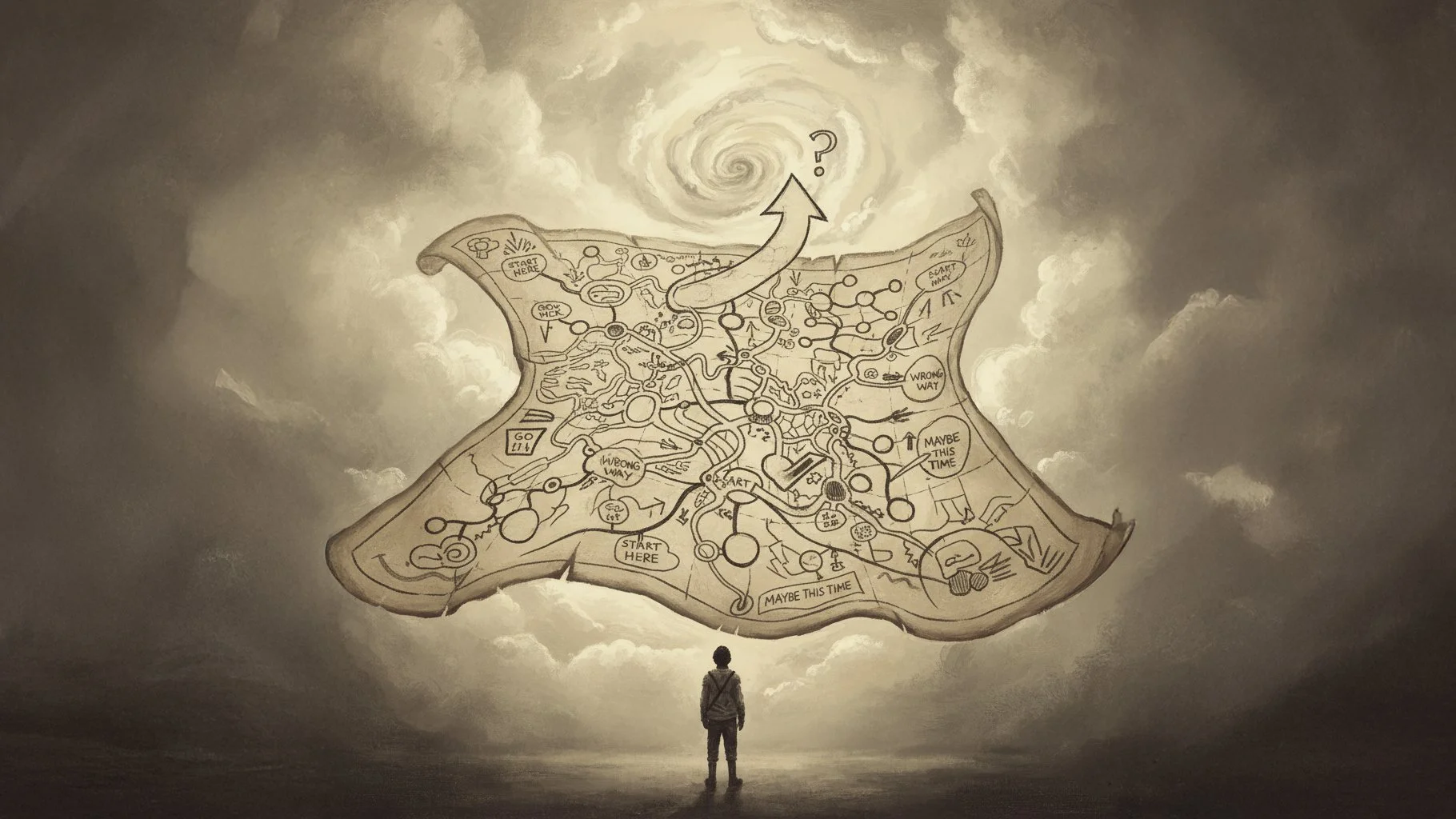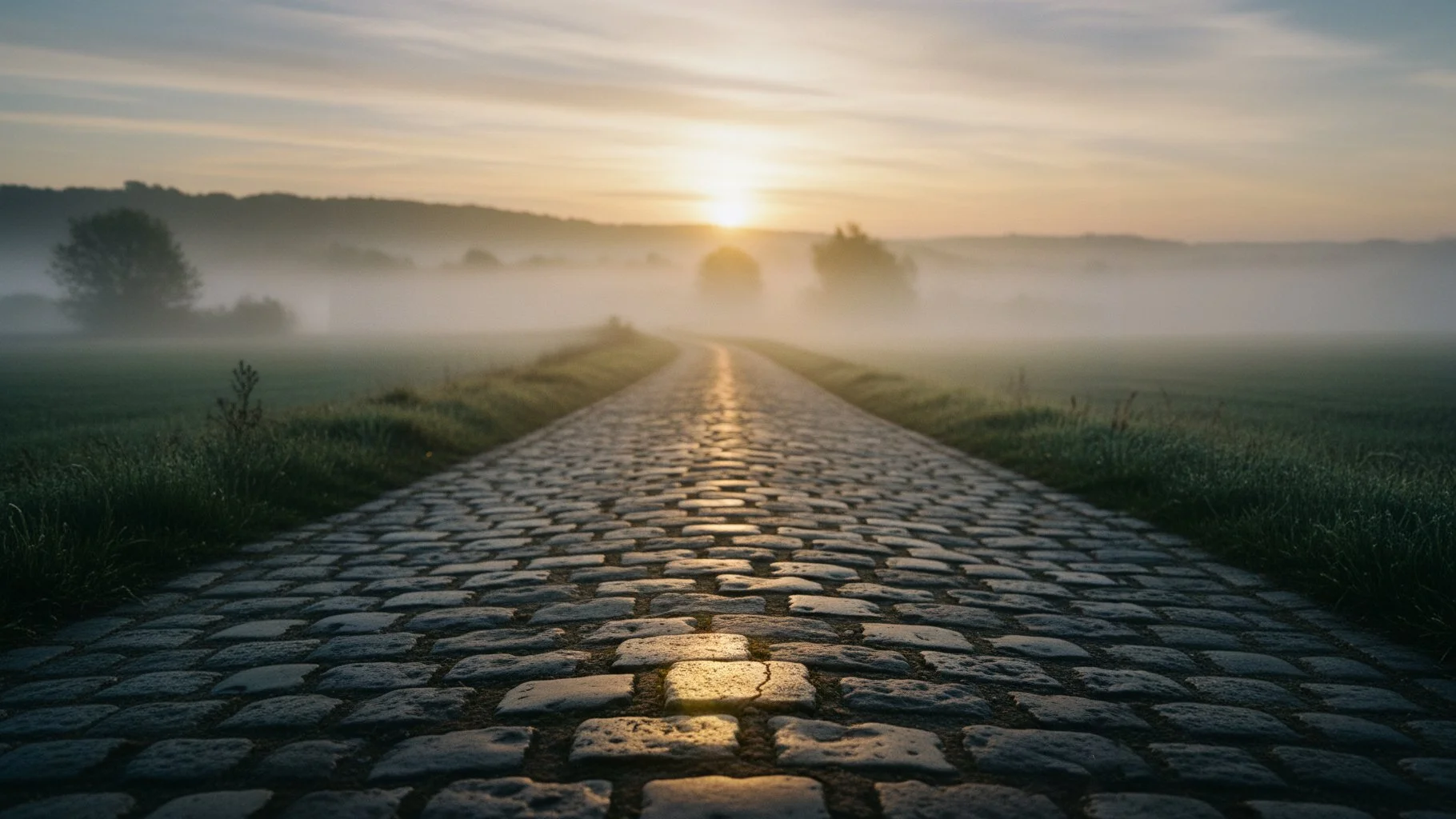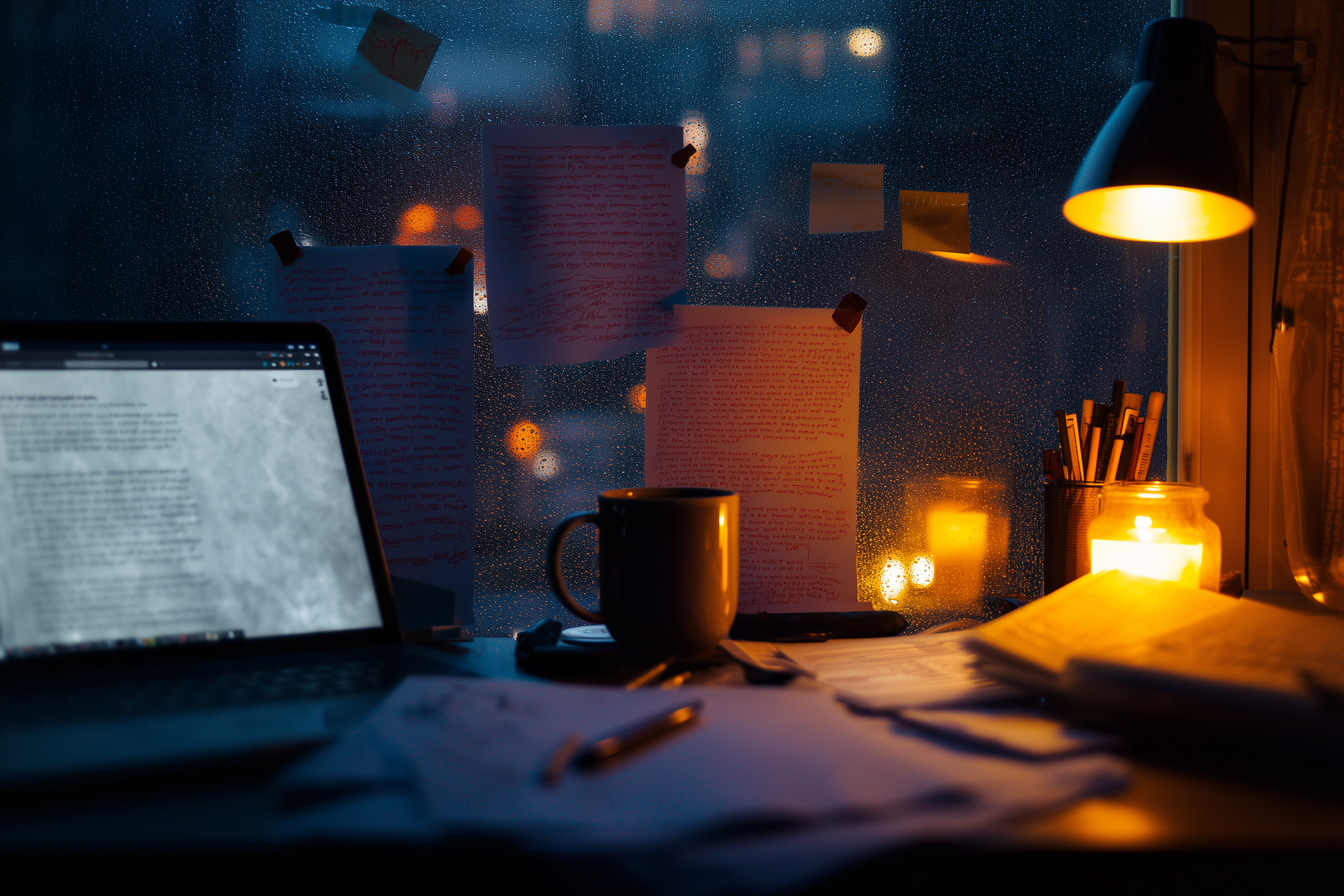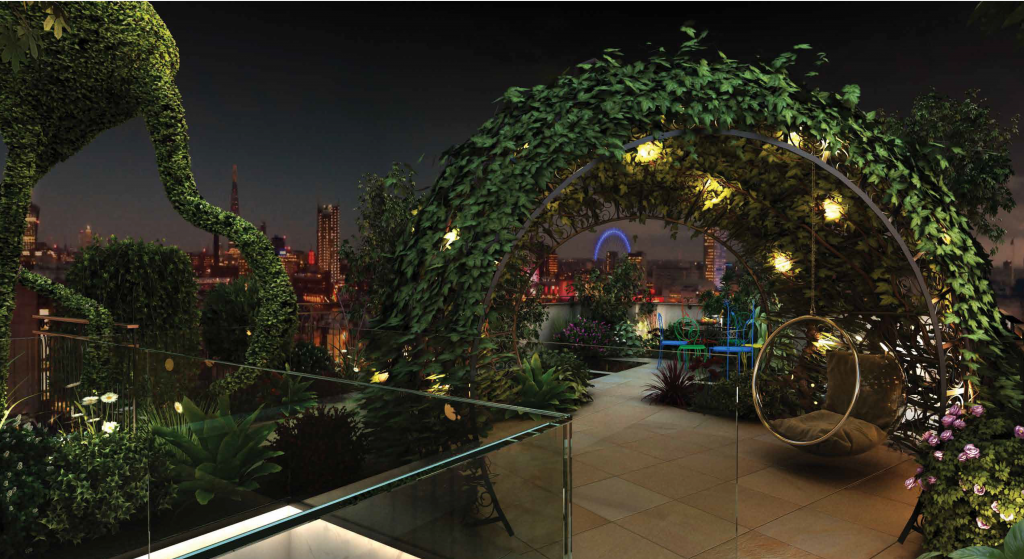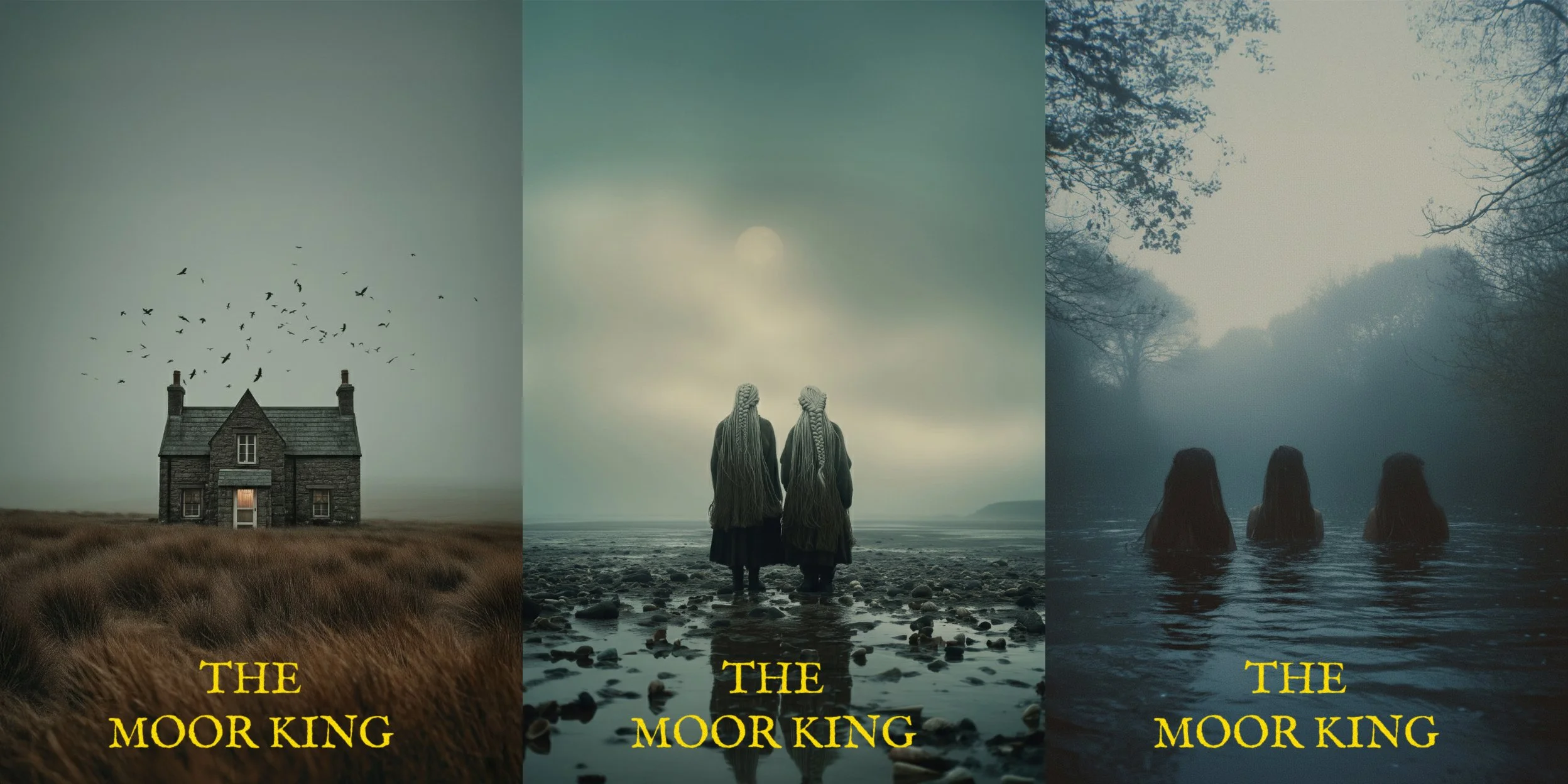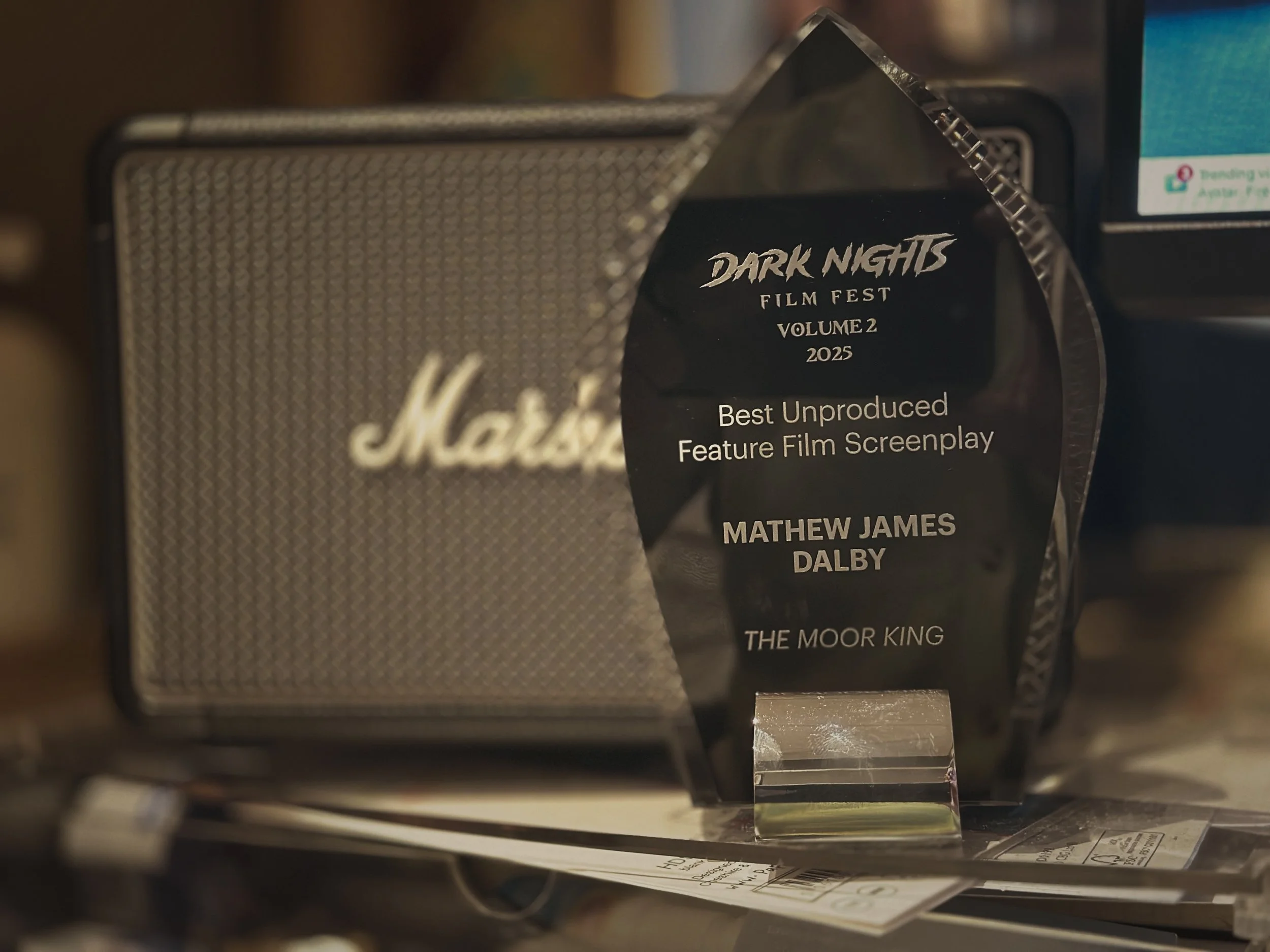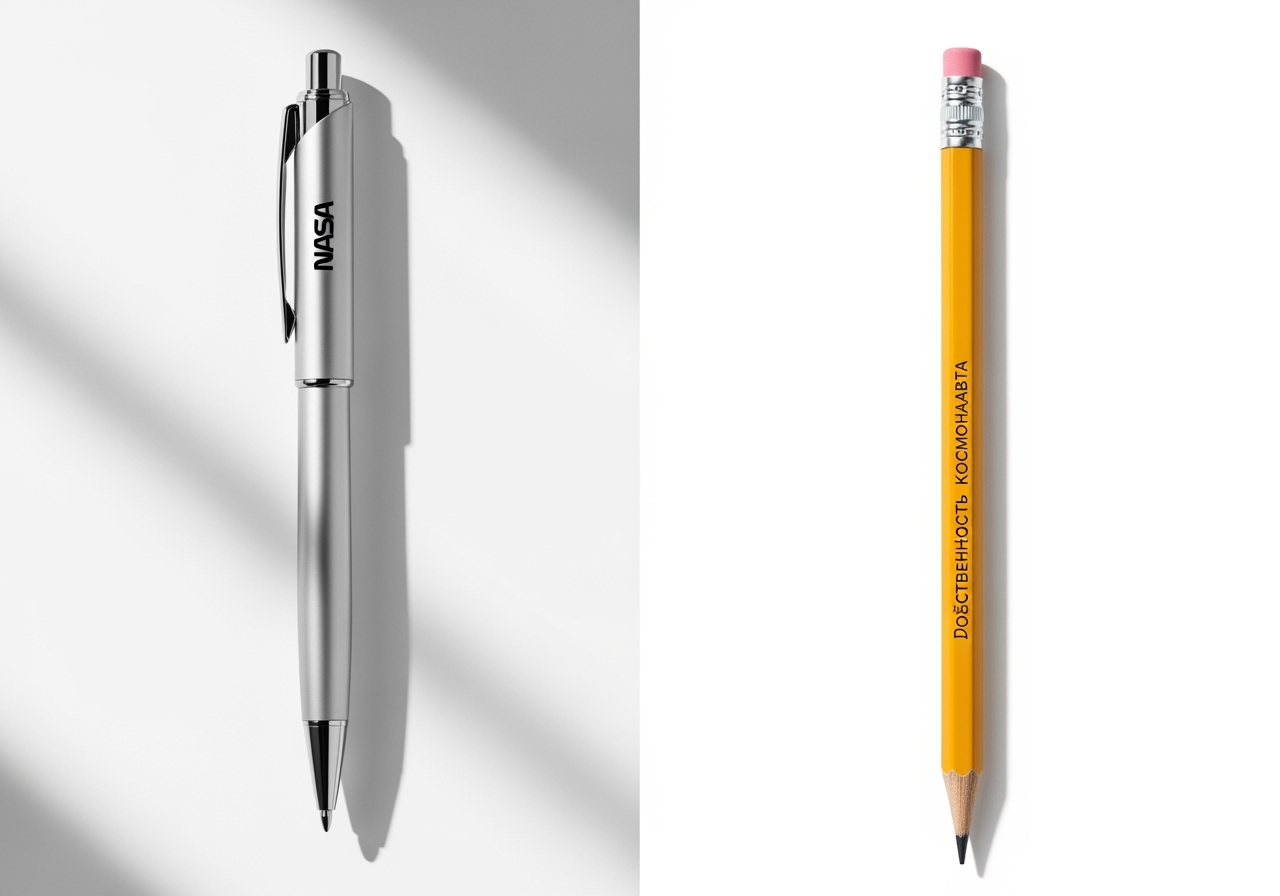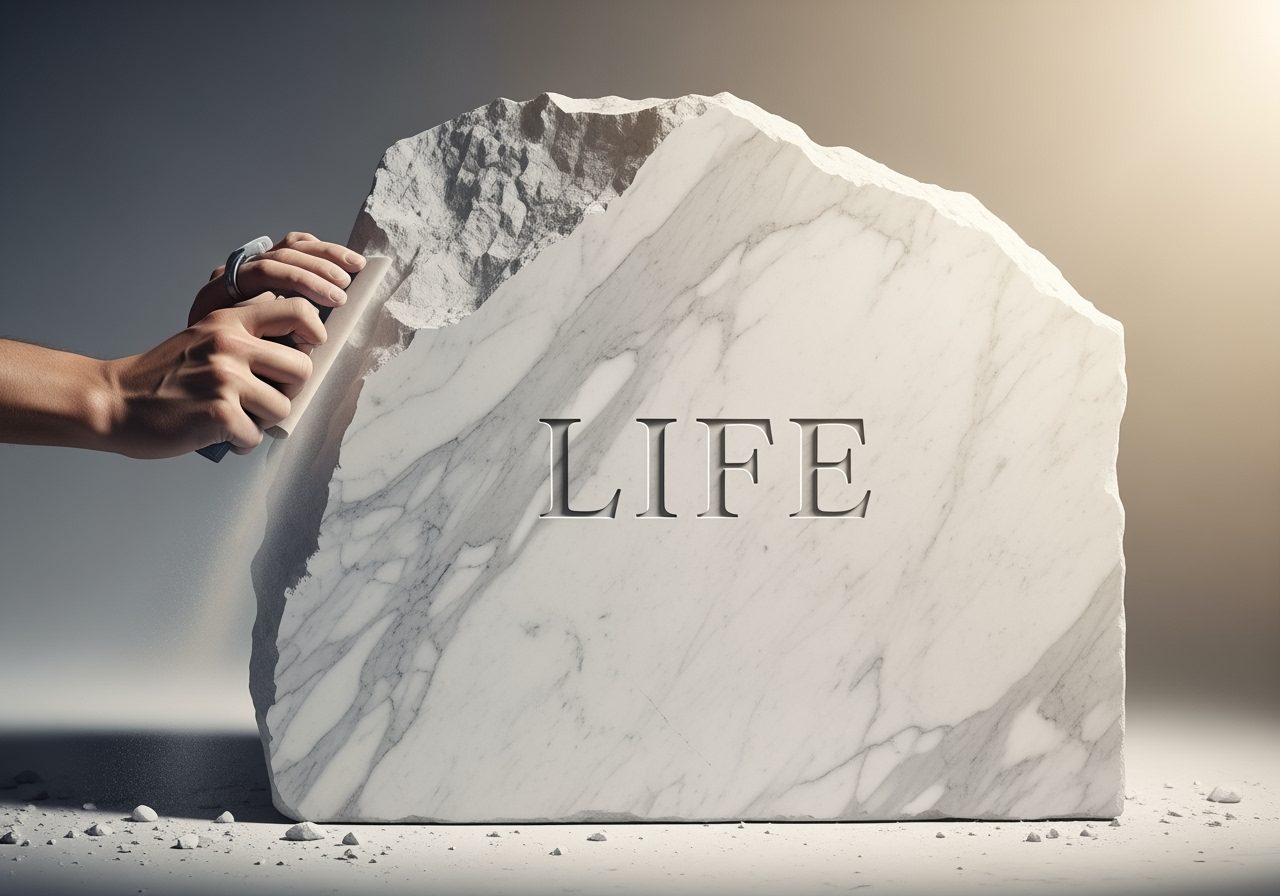Why I Ditched Long-Term Goals
Mathew Dalby on trading decade-long plans for 12-month focus. Why short-term goals build momentum, creativity, and joy — and how StudioFAB thrives on quick, sharp projects.
The Big Plan Illusion
For years, I adored a grand plan. The ten-year strategy. The whiteboard full of arrows. The “by the time I’m fifty, I’ll have…” list.
But here’s the quiet truth I’ve learned: long-term goals are often fool’s gold.
They sound noble, but they dangle just far enough away to keep you forever reaching, never arriving. You chase something so distant that you stop noticing the side quests — the unexpected turns, obsessions, people, or ideas that might’ve become something extraordinary if you weren’t so blinkered by your plan.
The Power of the Side Quest
History’s full of proof that detours can be more fruitful than destinations.
Columbus set out for India and found the Americas.
Fleming was trying to grow bacteria and stumbled upon penicillin.
Percy Spencer was testing radar equipment when a chocolate bar melted in his pocket — and voilà, the microwave was born.
None of them were following a decade-long roadmap. They were curious, awake, and paying attention to the world as it actually was, not how they’d planned it to be.
StudioFAB and the Short Game
At StudioFAB, we see the same thing in design.
Everyone loves the big projects — the ones that take years, a small army of consultants, and entire walls of drawings. And they’re brilliant, of course. But the short, sharp ones — the pop-up competition entries, the rebranding sprints, the one-off hospitality refreshes — those are where we stretch a different set of muscles.
They demand focus, speed, and instinct. You make decisions fast. You trust your gut. You find clever shortcuts. You rediscover agility. And sometimes, you surprise yourself with how inventive you can be when you don’t have the luxury of time.
Necessity is still the mother of invention.
Give me half a dozen quick, compact projects over one big behemoth any day. They keep the studio nimble, creative, and alert — and they remind us that brilliance doesn’t always need a three-year timeline or a $30 million budget. Sometimes it just needs a spark, a deadline, and a good cup of coffee.
Why Short-Term Wins Matter
These days, I set twelve-to-eighteen-month goals.
Tight, focused bursts. Something I can define, touch, complete. Then move on.
The win is real. The progress visible. The energy stays alive.
You learn faster, adapt quicker, and avoid the emotional fatigue of chasing a horizon that never gets closer. Small goals keep your momentum human — fast enough to feel progress, slow enough to notice the scenery.
Myopia and Missed Sunsets
When you live in long-term goal mode, you risk a kind of blindness. You’re so fixated on the destination that you miss the texture of the journey — the people you meet, the moments of calm, the small wins that quietly build a good life.
Let’s not trade every sunrise and sunset for a dream that might never deliver what you think it will.
Because those are the real dividends — the ones you don’t see until you stop staring at the far-off peak and notice the light on the horizon.
Small Stones, Big Path
Enough short-term goals, stacked with intent, tend to form a long-term one anyway.
But you’ll have lived far more of your life getting there.
No decade-long manifestos. No “vision boards for 2035.”
Just the next clear, achievable thing — done properly, with presence, and a little joy along the way.
You can keep chasing the summit if you like.
I’m happier building the path — one small, beautiful stone at a time.
This Weekend, I Became an International Award-Winning Screenwriter.
This weekend, I became an international award-winning screenwriter. What began as a late-night creative experiment has become an unexpected extension of StudioFAB — a reminder that design and storytelling are two sides of the same creative coin.
This weekend, I became an award-winning screenwriter.
Which is both delightful and faintly ridiculous. Delightful because it is true, and ridiculous because I still half expect someone to tap me on the shoulder and say, “All very amusing, Mathew, but back to the hotel drawings, please.”
I took up screenwriting late last year as a serious hobby.
Not golf. Not pottery. Screenwriting.
I thought it would be a harmless creative detour. A bit of cerebral stretching. Something to do when the rest of the house was asleep and the world had stopped demanding floor plans and value engineering.
The Accidental Writer
Fast forward a few months, and somehow there are now three screenplays with my name on them. Each has either won or placed in international competitions, and one of my other scripts is currently with a production company in Los Angeles.
It’s all a bit surreal.
But here’s the truth: writing didn’t feel like learning something new. It felt like remembering something familiar. After thirty years of designing hotels, homes, and the occasional palace, I realised that what I really do for a living is tell stories. Screenwriting is simply design without walls. The materials are different, but the purpose is the same.
Both ask: what do I want someone to feel?
Design, Story, and the Same Question
Design has always been my language. I choreograph light, texture, and space to build emotion. A lobby is an opening act. A corridor is suspense. A guestroom is resolution. The story of arrival, pause, and rest.
Writing is the same, except your tools are dialogue, tension, and silence. You still craft rhythm. You still edit ruthlessly. You still pray no one notices the joins.
Both fields demand empathy. A hotel succeeds when it anticipates its guests’ emotions before they do. A film succeeds when the audience recognises themselves in the characters. You build both from the inside out. You design for feeling, not function.
Lessons Between Two Worlds
Design taught me patience. Projects can take years. You learn to trust the slow burn. Screenwriting, on the other hand, demands precision. You have ninety pages to make someone care.
It’s merciless.
Every word must pay rent.
Yet that discipline makes me sharper back in the studio. I now look at drawings like dialogue. If a line doesn’t advance the story, it goes.
Creativity isn’t about invention. It’s about listening. When you design a space or write a character, you listen for what it wants to be. You remove what’s false until what’s left feels inevitable. That’s when it’s right.
On Winning (and Not Losing Focus)
The funny thing about winning awards is that people assume you had a plan. I didn’t. I entered one festival because the submission link popped up at midnight, and I thought, Why not.
Then I heard I’d made it to the finals, well, I was going to go anyway. But when they announced my name…
But once the disbelief wore off, what stayed with me wasn’t pride.
It was perspective.
Creativity doesn’t care about categories. It finds new rooms to inhabit.
And before anyone wonders, NO, I’m not taking my eye off StudioFAB.
Quite the opposite.
Writing has sharpened it. It’s made me see design in new ways, tighter, bolder, more narrative-driven.
StudioFAB remains my focus, my craft, and my home. The screenplays are simply another expression of the same creative muscle. I see it as a parallel practice that feeds back into how we think, how we see, and how we design.
Night Work
I still spend my days leading the studio, working with architects, builders, and hoteliers to craft spaces that make sense of chaos. But at night, I slip into another kind of world-building. One where walls are made of words, where atmosphere lives in subtext, and the soundtrack is the gentle snoring of the dogs.
It’s slower, lonelier, and oddly liberating.
Storytelling, in any form, is the purest act of empathy. You create a structure for someone else to step into, a place to feel something safely. Whether that space is a courtyard or a scene in a film hardly matters. Both are invitations.
Rediscovering Play
Screenwriting reminded me of something I’d quietly lost in design, the idea of play, the unguarded joy of making something purely because you can.
In design, we often prioritise pragmatism and accountability over curiosity, making it a luxury.
Writing reintroduced it.
That spark of let’s see what happens if…
Both my worlds feed each other. Writing makes me observant. Design keeps me grounded. One deals in story, the other in structure. Together, they form the full circle of creativity.
Staying Grounded
When a script began to gain traction in Los Angeles, a friend asked if I was tempted to leave design behind.
Not a chance.
The joy lies in the crossover.
To move from drawing a lobby to writing a scene is to shift between two dialects of the same language.
StudioFAB remains the engine. The writing simply adds a new instrument to the orchestra. The focus, as always, is on building, whether it’s a space or a story.
Closing Thoughts
So yes. This weekend, I became an award-winning screenwriter. And on Monday morning, I went straight back to the studio. The two are not at odds. They are the same craft, played in different keys.
Creativity doesn’t live in compartments.
It leaks.
It overlaps.
It misbehaves.
And that is precisely what keeps it alive.
The Gift of Constraint (and Why Perfection Needs a Good Kick in the Shins)
We tend to treat constraints as enemies — the budget too small, the site too narrow, the client too picky. But limits don’t kill creativity, they ignite it. The best work happens when you stop trying to do everything and start focusing on what matters. Here’s how structure, restraint, and a touch of discomfort can turn frustration into innovation.
“The very things that held you down are gonna carry you up and up and up!”
In the summer of 1501, Florence was facing a very Italian problem. Lying flat in the cathedral courtyard was a massive slab of marble, abandoned by two sculptors and described rather tragically as “a certain man of marble, badly blocked out and laid on its back.”
You can picture it, can’t you? A once-promising block, left sunburnt and pigeon-kissed, a sort of marble roadkill in the Renaissance sunshine.
For forty years, it sat there, too flawed to use and too precious to throw away. Then along came a 26-year-old sculptor, barely out of artistic adolescence, and with the sort of misplaced confidence we usually associate with first-year architecture students.
He took one look and said, “I’ll take it.”
The marble was awkwardly narrow, riddled with veins, and so brittle it made everyone nervous. But instead of fighting against the constraint, the sculptor leaned into it. The slab dictated the pose, the tilt of the head, even the famously oversized right hand — all the product of necessity rather than whim. The sword and Goliath’s head? Not missing, merely uninvited. There simply wasn’t room.
The sculptor was Michelangelo, and the sculpture was probably the most famous piece in the world, David.
It was the world’s greatest case of make-do and mend.
When finished, the statue was so magnificent (and so heavy) that the cathedral roof creaked at the thought of it. A committee — including Botticelli and Leonardo da Vinci — sensibly decided it would look far better on the ground, preferably where people could actually see it. And there it stood, redefining sculpture and proving once and for all that constraints don’t strangle creativity, they sculpt it.
Oh, yeah, his right hand is too big!
Constraint: the secret ingredient
As designers, we tend to groan when faced with limitations. Budgets, deadlines, local council guidelines written by people who have clearly never designed anything in their lives — all of it can feel maddening. But here’s the thing: creativity without constraint is chaos.
A blank page offers infinite freedom, which is another way of saying endless panic. Give that same designer a boundary, and they’ll turn into MacGyver with a mood board.
The value of design lies as much in what you leave out as what you put in. A great space breathes because you resisted the urge to fill every corner. A great idea sings because you stopped one verse earlier than expected.
Think of the Japanese haiku: seventeen syllables to express an entire season, a lifetime, or the unbearable tenderness of a falling leaf. Limitation, as it turns out, is poetry’s favourite muse.
Dr Seuss knew it, too. Challenged to write a children’s book using no more than fifty words, he produced Green Eggs and Ham, which went on to sell two hundred million copies. Proof, if ever you needed it, that being boxed in sometimes helps you think outside it.
The illusion of certainty
Our modern brains despise uncertainty. They rush to fill the silence with assumptions — quick, comforting, and often wrong. Psychologists call it confirmation bias. I call it creative taxidermy: everything looks alive, but nothing’s actually moving.
So, how do we keep the work alive when the unknown is breathing down our necks?
First, use three kinds of thinking in sequence, not all at once
Divergent thinking. Open the windows. Generate options, variations, and delicious oddities. Quantity before quality.
Convergent thinking. Close the windows. Sort, cluster, compare, and choose. Commit to a path.
Metacognition. Step onto the balcony. Notice how you are thinking, not just what you are thinking. Plan, monitor, and adjust your own process.
Now, give that trio a practical runway.
Do not sprint to a solution. Define the shape of the problem. Clarify the outcome you actually need. Write the challenge in one clean sentence. Then write the best-case scenario in one more. If it takes three, you do not yet understand it.
Remove assumptions. Make a list of everything you think is true. Cross out every line that you cannot back with evidence. Keep only facts.
Work the classic questions. What, Why, Who, When, Where, and How. Simple questions, ruthless discipline.
Ask Why, then Why again, and again, until the root presents itself. The Five Whys originated as a Toyota habit and remains an elegant way to dig beyond symptoms and uncover their causes.
Balance collaboration with solitude. Invite the room to diverge, then give people private thinking time before you converge. It reduces the risk of homogeneity, that slow drift toward agreeable mush. In the literature, it is referred to as groupthink, where the desire for harmony stifles alternatives. Do not let a tidy meeting strangle a good idea.
Test head and heart. Give each option a simple score out of ten for logic and a simple score out of ten for feeling. If the numbers wobble, you probably need to refine the brief or push the idea further out to the edge and bring it back with something worth keeping.
Once the shape is finally visible, create a plan. One page. Milestones, owners, and a date when you will judge success with cold eyes.
Extra Courage required?
And if you want a little courage for the road, remember a few true tales of persistence under constraint. Dr Seuss wrote Green Eggs and Ham using only fifty distinct words after a fifty-dollar bet from his publisher, and it became his most successful book—constraint in action.
J K Rowling’s first Harry Potter manuscript was turned down again and again before Bloomsbury said yes, a reminder that rejection often signals timing, not talent.
Angry Birds was not a first swing; it was Rovio’s fifty-second game, the one that kept the lights on.
As for Walt Disney, people often quote a specific tally of rejections, which is difficult to verify. What is clear is that many investors passed before television, money, and banking partners backed the park, and that is the part that matters for us.
The stuff of dreams OR that nightmares are made of…
“The right yes is often later than you expect. ”
Creativity does not live in knowing. It lives in not knowing. It is the delicate wobble just before a form reveals itself. It is stepping out on thin ice and listening to the cracks grow louder, until you finally break through and feel the cold bite of something real. That is the point. That is where ideas breathe.
So, the next time you are staring down a tight budget, a contrary site, or a brief that reads like a riddle inside a spreadsheet, do what Michelangelo did with his ill-tempered marble. Use it. Shape with it. Let it answer back. Your constraint is not an obstacle. It is the chisel in your hand.
Perfection is overrated. A little pressure never hurt a masterpiece.
Frictionless Living: Knocking Off the Harsh Edges, One Room at a Time
Frictionless living is not just about where you put the sofa or how cleverly you hide the bins. It is a philosophy that is physical, mental, and, if you will indulge me, even a touch esoteric. In our studio and our designs, it means something unique for everyone involved.
The Parable of the Space Pen and the Humble Pencil
There is a story, both legendary and instructive, about the great space race. NASA, determined to write in zero gravity, spent a small fortune developing a pen that worked upside down, in the vacuum of space, and presumably on a bad day. The Russian cosmonauts, meanwhile, simply brought a pencil. Whether or not this is strictly true is beside the point. The wisdom is in the lesson. Sometimes, the best solution is not the most complicated, but the one that simply works, letting you get on with the real business of living—or in our case, designing.
NASA pen, Russian pencil
Frictionless living is very much the same. It is about noticing the small things that slow us down, the invisible snags and unnecessary obstacles, and removing them with care and intention. For me, this idea became more than a design philosophy. It became a personal mantra, especially as I navigated and continue to navigate my own mental health journey. If you have ever stubbed your toe on a rogue charging cable at three in the morning, you will understand the appeal.
A Philosophy Born at the Kitchen Table
Before we left London, my wife and I made a quiet pact. We wanted to build a life with as many harsh edges knocked off as possible. Life, we agreed, is already an enthusiastic supplier of friction, so why add more? We decided to be mindful, to avoid creating unnecessary obstacles, and to remove any that we could. What started as a personal goal naturally seeped into our work, and now sits at the very core of StudioFAB’s ethos.
As literal as you can get!
Frictionless Living: Physical, Mental, and Esoteric
Frictionless living is not just about where you put the sofa or how cleverly you hide the bins. It is a philosophy that is physical, mental, and, if you will indulge me, even a touch esoteric. In our studio and our designs, it means something unique for everyone involved.
For the Client: The Invisible Hand of Good Design
Imagine living in a home where the hallway never bottlenecks, storage is conveniently located exactly where you need it, and the kitchen flows so seamlessly that you barely notice the design at all. This is not accidental. Research from the University of Exeter found that people living in well-designed homes experience up to a twenty five percent increase in daily well-being and a significant drop in frustration (Evans, G. W., & McCoy, J. M., 1998, Building Health: The Impact of Well-Designed Environments). When your environment supports you, life gets easier and you find yourself more at ease. It is the difference between feeling like a guest in your own house and feeling, well, at home. It is also the difference between gliding through your morning routine and performing an unintentional interpretive dance with a tangle of extension cords.
For the Developer: Simplicity Sells
For developers, frictionless living means spaces that are not only beautiful but also practical and marketable. Intuitive layouts, flexible rooms, and smart storage do not just make life better for the end user. They also reduce costly changes during construction and make properties more appealing in a competitive market. Developments that prioritise user-centric design have been shown to command premiums up to twelve percent above standard market value (Royal Institution of Chartered Surveyors, 2022). Simplicity, it turns out, is very good for business. It is the architectural equivalent of finding a forgotten chocolate bar in your coat pocket. Unexpected, delightful, and instantly rewarding.
Simplicity sells.
For the Builder: Clarity Means Progress
For builders, frictionless living is about clear plans and details that make sense on site. It is about fewer moments where someone stands in a half-built room and wonders what the designer was thinking. According to the Australian Construction Industry Forum, sixty percent of builders cited unclear design intent as the leading cause of site delays (ACIF, 2022). By making our intent practical and clear, we help the build flow as smoothly as the finished space. We aim to make the construction process more like a well-rehearsed symphony and less like a game of charades after midnight.
Where’s that designer?
The Esoteric Edge: When a Space Just Feels Right
There is also the intangible side. Frictionless living is about spaces that feel right in ways you cannot always put into words. It is the room that makes you breathe easier, the corridor that invites you in, the subtle sense that you belong. These are the details that make a house a home and a project a joy. It is the difference between a space that merely exists and one that quietly insists you put your feet up and stay awhile.
Anecdote: The Case of the Vanishing Cables
Recently, we worked with a client who was at their wit’s end with charging cables and plugs cluttering every surface. Their family had more than half a dozen devices that needed charging at some point during the day. The kitchen bench looked like a spaghetti junction, and the bedside tables resembled a scene from a particularly unhinged episode of a home technology show. The client’s plea was simple: “Can we make all of this disappear?”
We set ourselves the challenge of making charging both effortless and invisible. The solution was to design and develop both loose and fixed joinery items with integrated wireless charging mats, hidden beneath beautiful veneers and porcelain tiles. A simple nook in the kitchen, or the surface of a bedside cabinet, became a charging station. There were no visible cables, no plugs, just a subtle symbol to show you where to place your device. You simply put your phone or tablet down, and the magic happened. The effect was instant. The clutter and frustration vanished, replaced by a sense of calm and order. The client told us, “It is like living in the future, but without any of the mess.” Even the family cat, previously notorious for tangling itself in cords, seemed to approve.
This was not just a victory for aesthetics. It was a win for health and safety as well. According to a 2021 study in the International Journal of Environmental Research and Public Health, tangled charging cables are a surprisingly common cause of trips and minor injuries in the home, especially in families with children or elderly members (Kim, H. J., et al., 2021, Household Electrical Safety and Injury Prevention). By integrating wireless charging, we reduced both visual and physical hazards, creating a safer, more supportive environment.
Of course, some readers may worry about the safety of wireless charging mats, especially near where you sleep. The good news is that current research shows wireless charging mats emit very low levels of electromagnetic fields (EMF), well within international safety standards. According to the World Health Organisation and recent studies in the journal Bioelectromagnetics, there is no credible evidence linking wireless charging mats to health risks such as cancer or sleep disturbance when used as intended (World Health Organisation, 2023; Vecchia, P., et al., 2009, Exposure to High Frequency Electromagnetic Fields, Biological Effects and Health Consequences). If anything, the greater risk comes from tripping over a cable in the dark, or waking in the night to the sound of your phone clattering to the floor.
Silly Kitty
Why Frictionless Living Matters Now
Australians spend around ninety percent of their time indoors (Australian Bureau of Statistics, 2023). Our homes have become our offices, our sanctuaries, and sometimes our only safe harbour. When the world outside is noisy and unpredictable, our interiors should be a source of calm and support, not another source of stress.
At StudioFAB, frictionless living is not a slogan. It is a promise. We are here to knock off the harsh edges, to make life a little smoother, and to give you spaces where the only thing you notice is how little you need to notice. We believe that the best design is so quietly effective, you barely realise it is there. It simply works, and it works for you.
So, if you are ready to swap your space pen for a pencil, or would simply like to see your kitchen bench transformed from a cable jungle to a calm oasis, you know where to find us. At StudioFAB, we believe that life is complicated enough, so let us help you make your home the exception.
References
Evans, G. W., & McCoy, J. M. (1998). Building Health: The Impact of Well-Designed Environments.
Royal Institution of Chartered Surveyors (2022). User-Centric Design and Property Value.
Australian Construction Industry Forum (2022). Site Delays and Design Clarity Report.
Australian Bureau of Statistics (2023). Time Use and Indoor Living in Australia.
Kim, H. J., Park, S. H., Lee, S. Y., & Kim, J. H. (2021). Household Electrical Safety and Injury Prevention. International Journal of Environmental Research and Public Health, 18(7), 3456.
World Health Organization (2023). Electromagnetic fields and public health: mobile phones.
Vecchia, P., et al. (2009). Exposure to High Frequency Electromagnetic Fields, Biological Effects and Health Consequences (100 kHz–300 GHz). Bioelectromagnetics.


